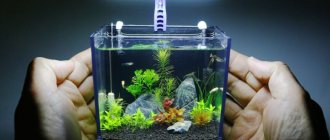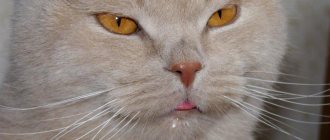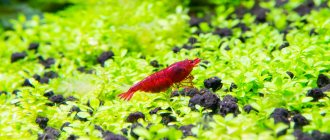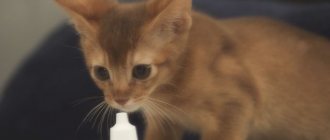A large percentage of indoor plants that decorate and refresh the home interior are extremely dangerous for cats. While it would hardly occur to a person to taste the leaf of an exotic flower, for an animal such actions are one of the main ways of understanding the world around him. In addition to curiosity, interest in plants arises due to a lack of vitamins. The cat also feels the need to periodically consume tough vegetation to cleanse the intestines of its own hair that enters the esophagus during the licking process. The results of such experiments can be very disastrous, from mild illness and stomach upset to severe poisoning and death.
Having decided to get a kitten, the owners are obliged to carefully study the properties of the potted greens present in the house and get rid of indoor plants that are dangerous for cats, giving them to friends or relatives. You should not be afraid that after this the apartment will be left without decorative greenery, because not all house plants are dangerous for cats; some species are not only not capable of causing harm to the animal, but can also become an additional source of vitamins and fiber.
List of dangerous plants and consequences
Poisonous indoor plants and flowers for cats are found in every third apartment, which pet owners are not aware of. The final effect depends on the amount and type of active agent in the structure of the leaves or stem. This could be vomiting, fever, bowel dysfunction, or more serious problems.
The eagerness of cats to gnaw flowers is not explained by increased interest or disobedience, but by cleansing the stomach of accumulated waste and toxins. The animal does not distinguish between useful and dangerous species, so the opposite effect often occurs.
There are several ways of infection. The most common is the consumption of leaves, flowers or stems of poisonous plants. Toxins also enter the stomach after drinking water from pot stands or eating soil. Particularly dangerous species infect an animal after physical contact with its fur or skin.
Flower shops rarely contain information regarding the toxicity of products, so before bringing a new plant into your pet’s home, find out in detail what effect it will have on the pet and all residents of the apartment.
The table groups the most common indoor plants that pose a threat to your pet.
| Name | What threatens |
| Geranium | Digestive disorder. |
| Evergreen boxwood | Serious intoxications, cases of death have been reported. |
| Azalea | Greens with bright flowers are fraught with danger - an alkaloid that is harmful to both cats and humans. If it enters the stomach, it depresses the central nervous system, provokes convulsions, swelling of the larynx, and disrupts the heart rhythm. |
| Cyclamen | If a leaf or stem gets into the stomach, it will end in vomiting, diarrhea, and abdominal pain. And if the kitten gets to the tubers, the risk of death is high. |
| Caladium | The leaves contain many dangerous acids, even a small amount of them leads to swelling of the larynx and chronic kidney dysfunction. But ingestion of juice is rarely observed due to its “burning” effect: when cats feel discomfort on their mucous membranes, they spit out the liquid. |
| Aloe | Aloe vera, which is healing for humans, belongs to the category of poisonous indoor plants and flowers for cats. Visually manifested as loss of coordination, lethargy, cramps, and diarrhea. |
| Anthurium | The poison is dangerous due to swelling of the mucous membranes and larynx. |
| Begonia | It acts in a similar way to the previous type, leading to burns of the mucous membranes and swelling of the oral cavity. Side effects are caused by the action of oxalic acid. |
| Hydrangea | Contains the most dangerous toxic substances - cyanides, which make breathing difficult, causing asphyxia. |
| Ivy | Decorative species are popular for decorating window sills, but are undesirable for cats - heart, kidney or pulmonary failure is guaranteed. |
| Sensevieria or pike tail | Allergic dermatitis. |
| Philodendron | Toxic substances contained in the leaves provoke swelling and have a detrimental effect on the kidneys. Burns to the mucous membranes after ingesting the juice are common. |
| Epipremnum aureus | Copious flow of saliva, swelling of the tongue and palate, pain in the stomach. |
| Asiatic lily | A toxic variety that causes vomiting, increased drowsiness, and loss of strength. Reduces appetite, provokes kidney failure. If you don't catch it in time, the animal may die. |
| Mother-in-law's tongue | Pain in all parts of the body, aches. Nausea, vomiting, stool upset. |
This is not a complete list of indoor plants harmful to cats, but all have similar side effects (swelling of the mucous membranes and larynx, diarrhea, vomiting, malaise, suffocation), the most dangerous ones being fatal.
The result will make itself felt after your cat tries one of the following plants:
- hippeastrum;
- zephyranthes;
- Eupharis;
- monstera;
- dieffenbachia;
- syngonium;
- oleander;
- mandevilla;
- Ardenia jasmine;
- Christmas Day;
- dracaena marginata;
- Usambara violet;
- peperomia, etc.
When poisonous houseplants and flowers for cats are discovered, remove them out of the cat's reach. If this is not possible, it is better to get rid of the plant. Be careful with calla lilies, sprenger ferns, crotons, and asparagus.
What other flowers should you stay away from?
Keep your kitten away from amaryllis, a poisonous flower; it causes convulsions, vomiting, increases salivation, and makes you feel depressing. The popular home flower Kalanchoe provokes dyspeptic disorders. After spathiphyllum, the mucous membranes become inflamed.
Schefflera will cause dermatitis on the skin, and euphorbia will cause conjunctivitis. The latter contains the potent poison euphorbine, which leads to nervous disorders and blindness.
For residents of the private sector whose pet loves to walk outside, it is important to know that trouble can also await them in their garden beds. Do not plant crocuses, pansies, calendula, oleander, daisies, poppies, tobacco, oregano, or dogwoods in your yard.
Instead, grow harmless asparagus officinalis, fittonia, basil, phlox, gerbera, lavender, and oregano. Decorate your yard (and at the same time nourish your cat's body with fiber, vitamins and minerals) by planting lovage, phalaenopsis, Russell's eustoma, passionflower, and Saintpaulia.
What flowers are useful?
Along with plants that are poisonous to cats, there are also flowers that are beneficial for them. Therefore, a pet owner looking to add indoor greens should choose from the “good list.” We already know which plants are dangerous and poisonous for cats. Here is a list of those that are recommended for cat owners to have:
- oats (although not a flower, but a very healthy and fortified plant for cats);
- indoor grapes, unlike wild ones, are not dangerous for cats;
- coleus;
- camellia;
- jasmine;
- begonia;
- Venus flytrap.
For those who live in their own home or often take their cat with them to the country, it is recommended to make a special front garden for the cat, where to plant useful plants. For example, these are: catnip, lemon balm, valerian, barley, oats, wheat, thyme. The cat can not only eat these plants, but also play with them: the stems and leaves are dried and small pillows and bags with a pleasant aroma are made from them, which then become the cat’s favorite toy. Symptoms of poisoning: what to look for and what to do
When dangerous plants enter a cat’s body, several stages of poisoning follow.
- Hidden stage when no signs are noticeable.
- The toxigenic period is when the poison begins to act and the first symptoms appear.
- The stage of the recurrent action of the poison (when, after improvement, symptoms appear again).
- Recovery period.
Poisoning can manifest itself as acute renal failure, burns, dermatitis and allergies. The manifestations are as follows: the animal is lethargic, does not show activity, its mood is depressed. Refusal to eat (primarily due to wounds and burns of the oral mucosa), vomiting, and diarrhea are often observed. If these signs occur, the animal should be immediately shown to a veterinarian, and the doctor should also be informed that there are plants in the house that are on the list of dangerous animals. Ideally, show a leaf of the same plant that the animal ate.
If it is not possible to immediately get to a veterinarian, then you should provide first aid to the animal yourself: give an enema or induce vomiting by pouring warm salted water into the stomach.
Treatment is usually carried out in a hospital. The duration and purpose depend on the strength of the plant’s poison and the time that has passed since its use. Sometimes gastric lavage is enough. If the poison is serious, the animal is in danger of death. In this case, in addition to washing, drug treatment is prescribed, and the pet is placed in a hospital under the constant supervision of specialists. The sooner the owner detects the symptoms of poisoning and the more detailed the poisonous substance is described to the veterinarian, the higher the chances of a successful cure.
Are bouquets dangerous?
Having dealt with poisonous houseplants and cat flowers growing in pots on your windowsills, it’s worth noting that bouquets can also be dangerous. Lilies, chrysanthemums, tulips or lilies of the valley, once they enter the animal’s oral cavity, disrupt movement, cause dermatitis, and indigestion.
The leaves and roots of irises provoke vomiting and diarrhea, and hyacinths contribute to the development of heart failure. Snowdrops cause allergies, stomach upset, and if a large amount of the plant enters the body, cardiac arrest.
Daffodils are characterized by diarrhea, vomiting, kidney and heart failure (bulbs, leaves and flower stalks are especially dangerous for cats). Gladioli lead to bleeding, certain types of lilac reduce appetite and weaken kidney function. If irises or calla lilies appear in the house, remove them away from the kitten, otherwise diarrhea, swelling of the larynx and irritation of the mucous membranes are guaranteed.
Precautionary measures
If the owner does not know whether dracaena is poisonous or not for cats, then he does not need to grow this flower in the house. You should always remember which flowers are poisonous to cats and which are not. It is advisable to keep only non-poisonous plants in the house, such as arrowroot, roses, coleus, cacti, catnip, violets (but not uzambara), cereals, basil, mint, thyme, lettuce, parsley. If, after all, there is a dangerous flower in the apartment, then it must be placed in the most inaccessible place for the cat.
Following safety measures and choosing the right home flora is a great way to decorate your interior without harming your pet. But before buying, you need to read the description of the flower and check the prohibited list.
First aid
Every cat owner should know how to act if an animal is poisoned by flowers. Provide first aid immediately, otherwise intoxication will intensify, and it will be more difficult to eliminate the manifestations of poisoning later. If you notice any oddities in your cat’s behavior or well-being, follow the algorithm:
- Give her a detoxification sorbent (for example, Polysorb, Adsorbent).
- Take the animal to the veterinarian as quickly as possible. Tell the doctor the name of the plant that poisoned the kitten (this will help make the correct diagnosis and prescribe treatment).
- Clean with soda solution (1 teaspoon per glass of warm water).
- To lavage the stomach, induce vomiting by introducing a warm solution of salt water. But you can resort to such a radical method only after consultation with a specialist.
- Inflammation in the larynx and other parts of the mouth is neutralized with a milk mixture with the addition of protein and oil (injected with a syringe).
- Before going to the doctor, you can “rinse” your stomach with a solution containing activated charcoal.
Ignoring malfunctions in the cat's body leads to toxins accumulating, depressing the functioning of the kidneys or causing gastric bleeding. If the slightest disturbance appears after the kitten has absorbed the leaves or stems of a flower from the windowsill (or vase), take the cat to a veterinary hospital.
How to tell if a cat has been poisoned
The first symptoms indicating intoxication:
- poor appetite;
- impaired body movements;
- drying of mucous membranes;
- lethargy (the kitten loses interest in games, spends more time in solitude, often sleeps);
- difficulty breathing (wheezing may occur);
- paralysis;
- vomit;
- bowel dysfunction;
- increased salivation.
Each cat goes through this process differently. If in one case the symptoms appear several hours after ingestion of the harmful plant, then in another situation the poisoning is protracted and chronic. How quickly the consequences will be felt depends on the amount of weed eaten. You cannot do without medical intervention, because it is possible to completely cure a cat only with drug therapy or in an inpatient setting.
Memo to the owner
Observant owners have noticed that cats also have an irresistible curiosity about new plants brought into the house. They love to smell them, play with them, touch them with their paws, or, most dangerously, taste them. They also recorded a love for citrus fruits, although they hate their aroma. Therefore, when purchasing flowers and herbs, it is advisable to obtain information about each plant to ensure their safety for pets. Here you already have to choose what you love most: flowers or cats. It is best to learn the properties of all plants than to deal with the consequences.
In addition to playing, cats eat suitable flowers to increase the amount of minerals and vitamins. While eating useful plants, cats may stumble upon dangerous ones. Therefore, in order to protect the lives of cats, it is necessary to create an atmosphere of calm and security. And to do this, you need to destroy those herbs in the garden and in the house that can lead to poisoning or death of the animal. It is also important to remember that fertilized soil or soil treated with beetles near plants can have a negative effect on them.
How to save a flower without harming your cat
Owners do not always want to part with poisonous indoor plants and flowers for cats, especially with an expensive, rare species or a valuable gift. What to do without causing damage to the cat’s health? The following precautions will help:
- place pots with poisonous flowers on the top shelves or on cabinets where the animal will definitely not reach;
- periodically spray the leaves of the plants with lemon juice (any other citrus will do) or put the fruit slices/zest directly into the pot - cats don’t like strong fruity aromas, so they definitely won’t go near the pot;
- Another bitter “anti-rodent” will also work: for educational purposes, spray the stem and leaves with the liquid;
- Place cacti in smaller pots around the cat’s main “enemy” in a pot, thereby creating a “thorny fence” (however, there is still a risk of the cacti tipping over);
- treat the windowsill with vinegar solution;
- hang plants on special plastic holders for pots;
- leave flowers in the loggia without letting the kitten in;
- alternate plants, growing species with a persistent aroma (tangerine, coleus dog, kincan) next to dangerous flowers;
- protect from small kittens with thick curtains, through which the cats will not be able to get to the potty;
- development of a reflex - a radical method of weaning a pet from chewing leaves and stems, consists of spraying the cat with a spray bottle immediately after he starts chewing the greens (after a couple of weeks of such prevention, the cat will forget the way to the desired flower).
In order not to deprive your pet of the pleasure of eating greens, buy special grass for cats at the pet store. It grows all year round. At the same time, you will be calm about the animal’s well-being, and the kitten will receive a complex of necessary vitamins and will not harm your favorite flower.
Safe window sill landscaping
There are plants that leave cats indifferent or even repel them with their chemical composition. These are crops such as lemongrass, calamondin, sheddock, panderosa, coleus canine.
You can replace poisonous plants with safe alternatives that do not harm most cats:
- jasmine;
- camellia;
- dracaena;
- peperomia;
- arrowroot;
- indoor grapes;
- coleus;
- Venus flytrap.
Be careful! These plants are considered safe for most cats, but due to the characteristics of the body, they can cause an allergic reaction in some individuals.
In addition to sprouted cereals, thyme, mint, including catmint, lemon balm and valerian can be called useful for cats. They should not be consumed a lot or often, but in small quantities they will not harm the cat and will decorate the window sills in the house.











